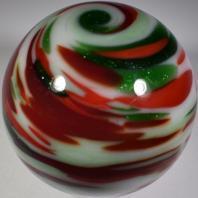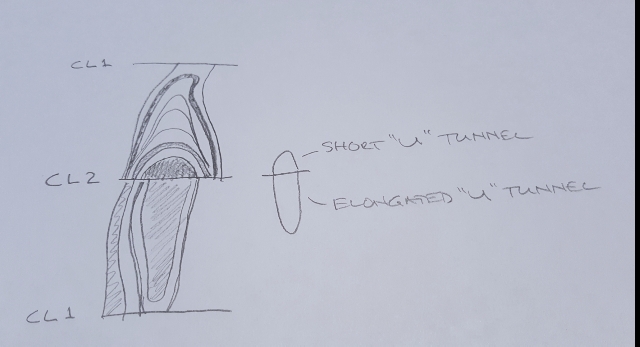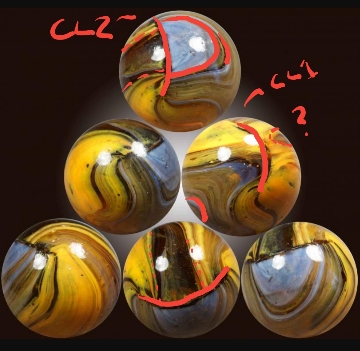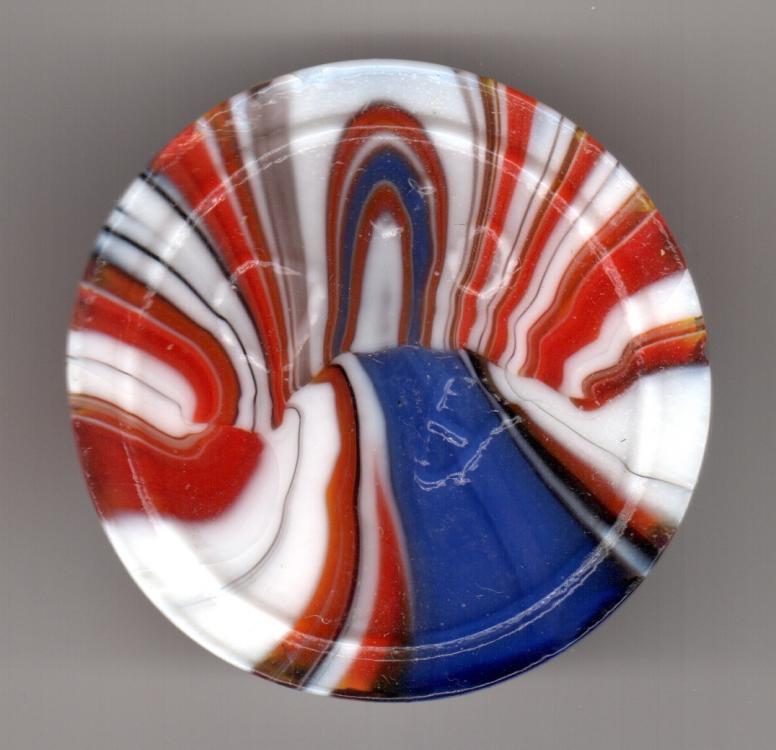-
Posts
670 -
Joined
-
Last visited
-
Days Won
1
Content Type
Profiles
Forums
Gallery
Events
Everything posted by Shamrock Marbles
-
Brian, Wonderful information. There are two rolling machines, both invented by Mr. Jenkins, and are the only ones of this kind in existence....the larger one has a capacity of 43 per minute, the other about 16. Thanks for sharing!!! Sincerely, John
-
Galen, John if you thought I was attacking you I apologize. Absolutely no need to apologize to me. No offence taken. But I do find your post slightly offensive as you ask several slightly attacking questions that you already know the answer and there really was no need for that. Galen, I'm a pretty direct guy. Again, the ambiguity of your sentence only leaves me guessing. I do know for a fact that many patents that are granted a number can be just like the drawings or vary any where from a little amount to a great amount(even the MFC pantent was altered in production) from what was actually used in production, if at all . A patent record is a true rarity. There are many more ideas, processes or machines that are never patented and are kept as "Trade Secrets". Some aren't handled like Trade Secrets, but companies just don't patent their intellectual property because it cost money. This is beside the point... What was your reasoning to bring in this point? Also I have not seen any actual same time writing about how things were being done at CAC. I think Brian has stepped up to the plate again! Thank you Brian!! So I am placing my OPINION on CAC by very little factual evidence at all. So yes IMO almost evreything being written about CAC manufacturing processes are nothing but assumptions and many are poor ones in my OPINION. I have no problem with anyone believing whatever they want. I would just love to see some factual evidence on how many of the marbles were made at CAC. Heck if someone wants to think that Cambridge glass was wheeled across the street to CAC melted into a cane, then marbles made from a cane good for them. I just do not have to believe it. Fair, I see your point. You don't have to agree. But if you do disagree, I think many would appreciate why you think that way. Sincerely, John
-
There are many choices. Too many to name and too easy to leave someone off. I would try to find an artist with marble styles and color combinations that you like and fit your budget. Prowl through the listings. If you find something you like, then go to their website and look around. In all honesty, most of the photos don't do justice to their work. Go to a marble show, if you can, and look at the tables. It's like puppy shopping, there will be one that will talk just to you. Wishing you the best on your new journey! John P.S. Don't forget to collect marble artists from the past! They pop up once in a while. Mark Block's books on Contemporary Marbles is a good snapshot of hot artists from 10 years ago. Some are still active and still very hot.
-
Do you have any factual evidence on what type of rounding machines , furnaces, shears or any other equipment that was used at the Christensen Agate Company?? If so I would love to study it. Here are my assertions: Howard M. Jenkins was an "employee" of Christensen Agate Company. The Howard M. Jenkins known to be employed at CAC is the one and the same Howard M. Jenkins that applied for and was granted US Patents 1,488,817 and 1,596,879. (Let it be known, that the name "Christensen Agate Company" are NOT part of either patents.) The dates of both patents coincide with the commonly published timeline of CAC marble production. Galen: Are you asserting that one or both patents are NOT associated with CAC? Moving on... With respect to CA and their equipment, the best "factual" information is what is in the US Patent record and their assertions. The rounding machines are described in US Patents 1,488,817 and 1,596,879. Both patents refer to glass being fed from both "gatherers" or "feeders". Only the second patent refers to shearing technology (see post above). What is apparent, is the omission of any reference to hand-shearing with a pair of manual scissors (like those used at MFC). Jenkins clearly shows and explains his shearing mechanism (Helicopter Shears). He also refers to shears on an automatic gob feeder being an integral part of that equipment. So, depending on that technology or supplier, those shears are usually mechanically timed to the gob feeder. Finally, Jenkins' patent refers to employing pneumatic shears ("in common use") when hand-gathering. Who's make and model are not exactly described. Homemade? Purchased from Miller? I will concede that we have no factual knowledge of the shoes sizes of any CA employees. However, your argument is that the lack of "hard" documentation voids all logic (unless your mind agrees with itself). Most of your posts boil down to: "No it isn't. Prove it." I haven't seen any of your logic or reasoning displayed in a public forum for group testing. Do you have any proof that your marbles were made by CAC? Would love to see your completely documented provenance (purchase orders, packing lists, sales receipts, etc.). Everything should trace back to the 1920's. --- I think almost all the info about CAC is assumption except they were the first to use gob feeders if my memory has not failed me completely. Okay, here's your chance to share with the community. Would like to know more myself. Looking forward to your response. --- I have examined numerous patents dealing with marble making that were never actually used any where Are you asserting that one or both of the Jenkins' patents were never used at CAC? Can you supply factual information to support? In support of your theory, you bring in a "red herring" of unemployed patents. I may be wrong, but my guess is that you're probably going to assert that Peltier's patent 1,865,787 was never used in production. If I am right, then please feel free to explain in detail why this was so, instead of alluding to vague references. (Mike Barton probably has files that you've seen or read.) Okay, you did use the plural of patent. If you do use the Peltier as an example, can you give us a second example and explain in detail why you know this was never used? If you don't use the Peltier as an example, then give us two examples with full detailed explanations. Just because a patent wasn't used in production, doesn't mean that Jenkins' patents were not used in production at CAC. Bad logic. Finally, would love to see your analysis and explanations of the numerous patents you've examined. Sincerely, John
-
I also qualified my statement by using "partially". There is also another way to get color down into the matrix. Sometimes a gather can get away from a worker and it begins to extrude off the end of the punty (darn gravity). "Drip and Wind" I've seen workers rotate the punty to wind the elongated gather back up into a ball. They usually lift the end of the punty upward while twisting. It looks like they are fishing. Not dissimilar to gathering molten glass out of a pot. I would consider this to be a natural reflex of a glassworker. "Drip and Loop/Fold" I've also seen where the elongated gather end is placed on a marver table. Then the worker loops the far end of the gather back onto the punty end. This creates a loop. I've seen it done twice to bring it back together further. I've also seen it Looped and then Wound. Either way, the glass had cooled too much and had to be reheated. John
-
Steph, When making items with sub-penny pricing, every minor detail can impact cost (profit/loss). The time it takes to clean off a punty would not be accepted. Even point-to-point travel distance is evaluated. It has been commonly stated that a pair of glassworkers at MFC could produce 10,000 marbles per day. Imagine if the marble machine was just 6-inches further away from the monkey pot. The Gatherer would have to travel 9,999 extra feet per day (1.89 miles) or 473 miles per year. This would be like walking from Akron to New York City. Little things can add up quickly. John
-
Galen, An "assumption" is a belief without proof. I'd like to think we've moved this cart down the road with a little more practical knowledge (you might not be in the cart). The law's of physics, economics and human nature really haven't change too much since the 1920's. I'd like to call it an "educated guess", but let's not quibble over labels. -- The fact is, Jenkin's design patent is founded on Hand-Gathering with his "suitable" shearing mechanism. To broaden his patent claims, he cites the removal of his shears for use with pneumatic shears (like Miller's design) and/or automatic gob feeders. Jenkin's "helicopter" shears spin twice for each funnel/wheel set. (That is one scary design. Where's OSHA?) It is because of this design, that you can experience a pre-cut (false cut-line) on the bottom of the gob as you lower it into the ring. When enough is hanging through, then you get a final cut-line as the gob is severed from the punty. Timing is everything. John
-
Craig, I apologize. I was responding to the "Twist Cane" artifact. Yes, I've seen your other beauties you've posted earlier (on this post and others). These are quite lovely. Photos like this are hard to gage size. With respect to the one on the right: 1) What length and diameter is that? 2) Do you have views available from all six sides? 3) How many grams does it weigh? All three show signs of completely melted/integrated frit. Along with additional unmelted frit attachments. I have seen (on Ebay or on a Chat Board) Guinea Marbles with some unmelted surface frit (not chipped). You've handled many Guineas, have you seen this first-hand in the wild? This goes back to my belief of Hand-Gathered Guineas. I believe these to be end-of-punty remnants that have broken-off. If you get the punty too close to the shears, you run the risk of over-feeding the punty into the cut-zone and the shears close on the metal rod. Bam!! Your shears are damaged (if not broken). So, a glass worker will always leave a bit of room between the end of the punty and the shears. [On occasion, I do err with my hand scissors and get all kinds of nicks on the edge (get enough nicks on your shears and you will get "eyelashes" at the cut-line).] See this photo that shows an "End of Punty Remnant": Now, what does the glassworker do with this remnant? Brett, Larry and Mark pull and cut off the excess, so it won't be part of the next marble. Me? I toss my punty in a water bucket and start with a clean rod for the next marble. What would a worker at MFC, CA or Akro do? They wouldn't waste time, so they would go back for another gather. Yes, new hot glass right over cooler glass. This can partially explain how you see some frit colors down inside transparent Guineas. If you do this, you need to reheat the subsurface glass. Hot and soft on the outside, while cool and hard on the inside. -- Now, one of the things I always wondered about was the "working time" of these glasses. Even among the contemporary glass I use today, the working time varies greatly. I find that certain opaque whites stay soft longer, while my cobalt blues and blacks get stiff quickly. What I am trying to figure out is: Was CA getting or trying 1) One gather = One marble, or 2) One gather = Two marbles? In the MFC court documents, this question was asked. MFC tried to get multiple marbles from a single gather, but had poor results. So, MFC stuck with One Gather = One Marble. In another post, an article about Akro described a single gather/single marble (non-twist) technique (for slags?). The problem with the "two for one", is that the glass cools exponentially. By the time you cut off the second gob, the glass has developed an enamel surface. If it cuts at all, you get a "hard cut-line" and wear your cutting blade out faster. I call it "cutting crunchy glass". Thoughts? John
-
I'm sure they did, but didn't care. Probably not much academic digging was done. Most people are looking for (what they think are) significant items to keep or sell. One guy digging may be looking for complete or near complete marbles and tosses the other stuff to the side. Another may be looking for something totally different. One man's trash is another man's treasure. Frit in dirt would be hard to sift out. Who wants to work that hard? https://www.youtube.com/watch?v=8PT5MS2POEQ I use the hot glass in water technique. Less work and dust. Sincerely, John
-
Who's to say yes or no? At one time, I too considered this thought. Could just be a miscellaneous doodling from a bored worker, broken onto the floor and then swept up with all the other glass debris. Only to be dug decades later. Could be ___________________. (<<Insert your idea in the "blank" to the left.) -- What if this was a base cane fed into a machine? Over the years, have you seen a Guinea with double cut-lines with long ribbons of color in a "cork" twist from end-to-end? Yes? No? -- Try thinking about standard ways glass workers made things. Try no to be overly complex. Keep it simple. The more time it took to make something, the fewer made per day with a higher unit cost. (Might explain the extinction of the Guinea and it's famed Company.) -- Automation was the mechanical/electrical means to replicate what a person did. M.F. Christensen improved the rounding process. Miller created an "on demand" pneumatic shear to replace a human with a pair of scissors. Miller further improved the rounding process. Akro had a spinning cup to replicate a glass worker twisting a cane. Peltier had their forehearth technology to "ribbonize" a glass stream ahead of the shears. -- Pretzel making machines today are designed to replicate manual efforts. Old way: https://www.youtube.com/watch?v=C2EihnC0hUw Newer way: https://www.youtube.com/watch?v=3eH_XSrZpX0 (Machines don't drink on the job.) -- Here is a Fenton / Dave Fetty Mosaic Turtle: A simple base glass, rolled in colored frit. The manipulation of hot glass will stretch a "dot" into an "ellipse". More stretching will result in a "line". I say that a "line" is nothing more than a stretched "dot". Closing shears will pull the glass together. Thoughts? Sincerely, John
-
Craig, Super sweet artifact!! Don't ask me why, but I enjoy the "oddball" stuff just as much as the "real deal"!! I believe it has found a loving home, where it is appreciated. Sincerely, John
-
About that. Focus on a quality torch and kiln. For 17 years I've used a GTT Lynx torch and a Jen-Ken kiln (11" dia x 6" tall chamber). Both bought as new. I use dual Airsep concentrators. Picked up as used rebuilds. Check Craigslist for low hour units. The best tool to start is a 5-in-1 Infinite Rim Graphite Mold from Dan Grumbling. Stainless steel punties cut from welding rod. Last but not least, get proper eye protection!! John
-
Ric, My heartfelt sympathy to you and your family. John
-
Sweet! I still remember my first hand-made marbles (and still have them). Don't give them away. Mark them in sequence (1801, 1802, 1803, etc.). I kept my first 100 marbles before I sold one. Pick a number for you. Might be 10, 25 or 50. I like looking at the progression of my skills and the techniques I tried. Thanks for sharing and keep up the enthusiasm! John P.S. Get a copy of Drew Fritts' book.
-
My opinion: 1) Contemporary. 2) Polished down to remove one or all these: signature, boil bubbles on edges of the spots, out of roundness, rough surface or punty marks. In the photos, there appears to be a slight twist and a definable North and South Pole. As with any opinion, YMMV. John South Pole North Pole Revised opinion on "North Pole": I think there was a faux cut-line at the North Pole. There is a "straight" feature, plus a parallel "shadow" just above. That "shadow" is what happens when the glass comes into contact with the scissors (or shear). North Pole (Revised)
-
One on Ebay right now? https://www.ebay.com/itm/1-3-16-Spotted-China-Marble-with-a-Green-Base-by-Robert-Brown-Unsigned-Mint/173165860669?hash=item28517d573d:g:cUAAAOSwrhBZC7nY John
-
There is an old post in the "Archives". Bob Block had a couple photos. John
-
Okay. I'm confused. April 1918 - 6 machines is clearly stated. September 1917 - 10 machines. True, I am extrapolating the quantity. 150,000 per day and each machine doing 15,000 per day. Simple math. Being quite familiar with trade magazines, I am going to have to claim some exaggeration or artistic license is going on by either Akro or the writer. Thoughts? John
-
Part 2 Above is a sketch where I've tried to cut, unfold and flatten your marble. What I was tying to say is that you have a short "U" (Tunnel) and an elongated "U" (Road). If the first shear had removed more glass, any remnant Road U would have been cut off and the lines would appear to be parallel. Look at that marble and follow the lines. Imagine if your marble only had one cut line. You can trace some of the lines as they loop around the sphere. John
-
Winnie, Sorry, let me try again. Above is your photo. Let me define "Cut Line 2" as the one that is the focal point of the Road & Tunnel. "Cut Line 1" will be opposite and only shown on the marble in Row 2, Right. I've tried to outline the "Road" with a dashed red line. It appears that the road doesn't completely make it to CL1. I've placed a question mark on the view in question. John
-
Winnie, Your marble is fantastic! I am wondering if you have a double tunnel marble. There isn't a clear photo of how the "clear" tunnel is truncated at the 1st shear mark. The base of the white tunnel is what I would call the 2nd shear mark. John
-
Brian, Again, thank you for sharing your experiences. The "Twist" versus "Dip" definitely has me thinking. Surely, they would result in different patterns. The "Twist" would be a "9" and the "Dip" could give you a "U"? The production rates, also, have me thinking. More later. Do you have a date on the 2nd article? It appears that the number of machines has grown from 6 to 10. Also, it appears they have moved from manual feed to automatic. You bring up a point. Do Akro Slags have similar construction features as CA Slags? Now, I have always been curious about the working time of the glass used to make marbles way back then. A longer working time would allow the glass to stay plastic and minimize a shear mark, while allowing the forming machine more time to form a sphere. Thoughts? Sincerely, John
-
Brian, Always a wealth of knowledge! Thank you for sharing. So that may explain a variation in Slags. At the beginning, when the color pot (transparent purple, blue, green, amber, etc.) is "fresh", the marbles made would have a nice clean transparent base with white striations. After running for some time, any excess white not picked up in the gather would start to bleed and mix with the transparent base. So, slags toward the end of a pot would have a "cloudy" or "milky" transparent base. Thoughts? The comment "do not gather but dip the glass" is very interesting. Thoughts on what this means? Hope all is going well with you. Sincerely, John
-
Winnie, I don't know if anyone can definitively answer your question with a 100% "Yes" about your German sample. I don't recall ever seeing anyone post information as to what technology the German's employed and the relevant time-frames. It would be safe to say that the consensus was that 100% of MF Christensen marbles were "Hand Gathered" and "Machine Rounded". It would be safe to say that early Christensen Agate marbles were "Hand Gathered". It would be safe to say that later Christensen Agate marbles were "Machine Stream/Gob Fed". Now where it gets dicey, is what varieties were "Hand Gathered" or "Machine Stream/Gob Feed". All is open to argument. Others might add that early Peltier and Akro marbles were "Hand Gathered". Some might argue that the early Akro "Hand Gathered" marbles were actually purchased MFC stock. I think what Chris is stating that his marbles derive their pattern from the "twisting", "stretching" and "folding" actions done while "Hand Gathering". He is also implying that the MFC 9 and CA Diaper Fold patterns were generated by "Hand Gathering". Personally, I agree. Here is an Andy Davis Marble/Top Stand. I believe these are single "Hand Gathered" and then sheared off into a press/mold. Notice the beautiful striations and "Road and Tunnel" pattern? Obviously, Chris' marbles and Andy's stands have a single shear mark. Your German marble exhibits two shear marks. It is this twin feature that lead some to believe that this was "Stream Fed" and not "Hand Gathered". My belief is that a "Hand Gathered" marble can have a single shear mark, but also two shear marks. Sincerely, John
-
Steph, Same as the marbles. The forehearth technology was the same. You just rolled your "forming" machine underneath. Sincerely, John



.thumb.jpg.bcd514cc93ffd78c57dd1d1fba52fd3d.jpg)
.jpg.04a02814c000e9bff0645b811afd3781.jpg)
.jpg.f428deaea82b677e74dee420a1559679.jpg)












.thumb.jpg.5ae42e60567e9b3789658b2dcfd32ee4.jpg)